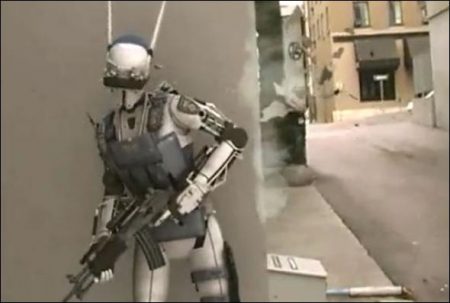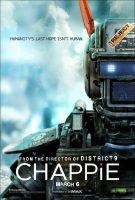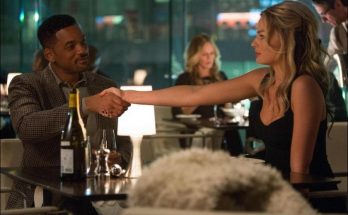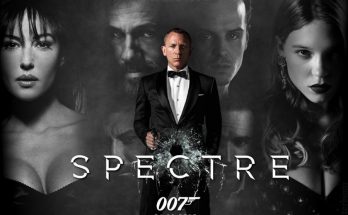Tagline: Humanity’s last hope is not human.
Every child comes into the world full of promise, and none more so than Chappie: he is gifted, special, a prodigy. Like any child, Chappie will come under the influence of his surroundings – some good, some bad – and he will rely on his heart and soul to find his way in the world and become his own man. But there’s one thing that makes Chappie different from anyone else: he is a robot.
The first robot with the ability to think and feel for himself. His life, his story, will change the way the world looks at robots and humans forever. After being kidnapped by two criminals during birth, Chappie becomes the adopted son in a strange and dysfunctional family. Chappie is preternaturally gifted, one of a kind, a prodigy. He also happens to be a robot.
Chappie (stylized as CHAPPiE) is an science fiction film directed by South African Neill Blomkamp. The screenplay, written by Blomkamp and Terri Tatchell, is based on Blomkamp’s 2004 short film Tetra Vaal. The film stars Sharlto Copley, Dev Patel, Jose Pablo Cantillo, Sigourney Weaver, Hugh Jackman, and Watkin Tudor Jones (Ninja) and Yolandi Visser of the South African zef rap-rave group Die Antwoord. The film, set and shot in Johannesburg, is about an artificially intelligent law enforcement robot captured and taught by gangsters, who nickname it Chappie.
About the Film
In his films District 9 and Elysium, filmmaker Neill Blomkamp invited viewers to reimagine our world. In those films, Blomkamp combined pulsing action with a social conscience that made the films unforgettable. In his new film, Chappie, Blomkamp is at it again.
Set just a few years from now, the world is under the thumb of autonomous, robotic police droids, called Scouts. “They can’t be reasoned with, they can’t be negotiated with, they cannot be swayed,” says Blomkamp.
With the entire city under the so-called “protection” of the police droids, in comes an entirely new creation – Chappie, the first robot that can think and feel for itself. Once a police droid, Chappie is stolen and put to entirely different purposes.
There are those, like Vincent Moore (Hugh Jackman), see a thinking robot as the end of mankind – after all, when a machine can think, what does it need a human for? But others, like Chappie’s creator, Deon Wilson (Dev Patel), see Chappie as a living, breathing, and entirely human form of life – and the last hope for humanity, even if he isn’t human himself.
“The idea was to take something as unhuman as a robot – especially a police robot – and give him complete human characteristics, to the point that he becomes more emotional than the human characters,” says Blomkamp. “That’s the backbone of the irony of the movie – a police droid becomes sentient, and begins to display characteristics that are more moral, ethical, and conscientious than human beings tend to.”
In the film, Blomkamp tells the story of a young, impressionable mind – the robot, Chappie – who falls in with the most unlikely of influences. “Chappie is quickly pulled into the seedy, crime-ridden underworld of Jo’burg, and he’s raised by two parents – one good, and one bad,” says Blomkamp. From here, Chappie is caught between powerful forces – and when those forces face off, an entire city hangs in the balance.
Simon Kinberg, who produces the film with Blomkamp, notes that Chappie fires on all cylinders because Blomkamp does what he does so well: the film combines the big ideas that obsess the filmmaker with an action-packed, highly entertaining story unlike any other. “He’s made an action movie that is also a dramatic character story that is also an intellectual study about what it means to be human, what it means to have intelligence. The most important thing in the film is that the audience falls in love with Chappie, that their hearts break when Chappie is hurt and are excited when he is victorious. You root for this robot. The movie does a lot of different things in a way that only Neill can do.”
“The film raises questions – when would a robot be considered human?” asks Sharlto Copley, who plays Chappie in the film. “Is it because they can paint, or like a certain kind of music? For humans, it would probably be if the machine had feelings – if we were connecting with a machine in the way that we connect with people. I think that’s what would make most people call a machine ‘alive’ – if it experiences emotions in the same way as us.”
The lead role of Chappie – a Scout who is given consciousness by artificial intelligence – is played by Sharlto Copley. Copley performed the role on camera, performing in each scene opposite the other characters. Not only did this allow Chappie to feel like a very real and authentic character, but it helped the other actors to bring their characters out to the fullest. Later, in post-production, Blomkamp worked with the wizards at the VFX facility Image Engine to bring Chappie to fruition, painting the robot Chappie over Copley’s performance and creating the robot from Copley’s movements. The way that Copley emoted in his scenes informed everything about the robot – from the way Chappie moves, or sits, or holds his head… even Chappie’s ears.
In many films with CG characters, the filmmakers sometimes choose to film the scene with only the live-action actors as they perform against only a single point. That was never going to happen on Chappie. “There was never going to be a world where we filmed with a tennis ball on the end of a C stand,” says Kinberg. “It was always going to be real and in the moment.”
“Sharlto’s performance is the thing that brings Chappie to life,” Kinberg continues. “He is so human and sad, touching and vulnerable. You feel it in his body language and voice – everything takes its cue from Sharl. The way the robot’s eyes move, the way its ears move, and certainly the way its body moves – all of that is dictated by Sharlto’s performance.”
Kinberg also says that having Copley performing the scenes helped all of the actors. “For the other actors, when you’re interacting with a real person, it all feels more real, human, textured and grounded,” he explains.
Copley says that in some ways, the role was like any other. “Neill said, ‘You just play the role, and we put the robot on top,'” the actor explains. “The film should work with me in the grey suit – you should still be able to watch the film and be moved by it.”
Copley notes that Chappie is unlike any role he’s ever played before. “It was quite interesting for me, movement wise,” he says. “I had to be very aware of every mannerism. The essence of Chappie is in how he moves and how he reacts – and not necessarily what he’s saying.”
Even though he would never be seen on film, Copley wore two pieces of costume attire to help get the character right. “I wore a chest plate, to keep my back and chest proportions the same as Chappie’s,” he notes. This allowed Copley to know what spaces he could fit in and how the robot would sit or stand in certain positions. In this way, when an actor grabs Chappie’s shoulder or chest, the actor’s hands are in the right place when Copley is replaced by Chappie in the computer.
But the chest plate wasn’t all. “I wore a grey suit with tracking markers for the animators. It was skin tight, and skin tight clothing is not gangster,” he says. Needing something that would help him feel like a gangster, Copley added a pair of shorts and a belt. “During the gangster scenes I would loosen my belt and drop the shorts half way down my backside. That was my trick, to transform from grey suit man into gangster Chappie. It helped create the right kind of gangster movements.”
Copley says that the unconventional style of shooting and animating the film was a great benefit. “Animators will tell you there’s a huge difference between animating something from scratch and working with what an actor has already done,” he says. “It’s a lot easier for them to create a moving character if the base performance is already there. Obviously, it’s also a lot better for the other actors to have a grey suit actor actually on set that they can interact with.”
“Chappie’s animators are incredible,” adds Copley. “They’ve managed to capture and translate every nuance of my performance. In addition, they had the challenge of trying to translate my facial movements onto Chappie, who has almost no face. They did an incredible job. I feel like they elevated what I gave them together we created some kind of unique being. ”
Taking on the role of the film’s villain, Vincent Moore, is Hugh Jackman. As an engineer who is very opposed to the idea of artificial intelligence, Vincent takes Chappie’s advancement personally, as Simon Kinberg explains. “Vincent is a twisted, militaristic, aggressive, insecure, brilliant scientist who believes the world needs this massive weapon he’s created,” Kinberg says. “He’s sacrificed everything for this program. He was a soldier, and to get what he wants, he takes some insane, extreme tactics. He’d light the city on fire to get what he wants.”
“I don’t think I’ve ever had as much fun playing a character as Vincent Moore,” says Jackman. “He’s an Australian, so it was nice to use my own accent. The key to understanding Vincent is he will not lose. Even when the odds are against him, even when all the signs are pointing in another direction, that’s when he fights harder. He feels what he is doing is so important, that he can’t accept anybody else’s direction or even the fact that anyone else can win.”
Because he rarely plays a villainous role, Jackman relished the opportunity to play a realistic villain with a justifiable point of view. “The best villains don’t think they’re villains,” he says. “He brings a genuine argument to the table, and he’s convinced that what he’s doing is right and necessary. What makes him a villain is his inability to lose. That trumps everything and he becomes very destructive, very angry and vengeful.”
Kinberg, also a producer of the recent X-Men films, has worked with Jackman on four films. “He has that movie star magnetism,” explains the producer. “He’s had it since that first X-Men movie, I’ve seen it on stage. In this movie, he obviously still has that, but it’s completely different, because he’s playing the villain. I think Hugh was excited to be playing an Australian – there’s a certain Australian archetype of the athletic bully, and he was definitely accessing that. This was a chance for him to play a whole different side of himself as a performer.”
Vincent’s opposite is Deon Wilson, Chappie’s creator, played by Dev Patel. A young engineer developing artificial intelligence, he’s in direct opposition to Jackman’s Vincent. “Most of all, Vincent hates artificial intelligence,” says Jackman. “He thinks that’s humans playing God. He argues that crime is unpredictable, so it’s a human issue, and it’s vital for any weapon to be controlled by a human.”
Deon represents the new wave of programmer, according to Blomkamp. “He has the spark of youth about him,” says the writer-producer-director. “I wanted him to be a prodigy – an Oxford or MIT artificial intelligence research student that the company gets their hands on, but who quickly finds that the company’s goals for him are very different from his own goals – and so all of his spare time goes to his own true love.”
“Deon’s real passion is in creating artificial intelligence – being a party to creating the next step in evolution – but I think it’s also because he just wants a companion,” says Kinberg. “He doesn’t connect with too many people – he lives in his head and his computer. He falls in love – as a brother, a friend, and a mentor to Chappie.”
Patel says that the character changed between the time he first read the script and shooting the scenes. “When I first read him, I completely related to his heart. I knew he was intensely passionate about artificial intelligence, but I was worried he might be too passive in some scenes. Then, I got to the set and I met Sharlto and NINJA and YO-LANDI. After meeting them, it was a natural reaction to give the character more of a backbone, to be more defensive and aggressive about his work.”
What was it about NINJA and YO-LANDI? “I didn’t really know of them before we started shooting; I’d heard whisperings about this crazy band from South Africa, Die Antwoord,” he recalls. “They’re absolutely fascinating; they play a version of themselves, which is great, because it’s just truth. It’s as raw and organic as possible. They bring themselves to this movie, and create this wild juxtaposition.”
Acting opposite Copley, Patel watched as Copley created a wholly original character. “Sharlto is kind of like Deon – he’s so crazy passionate that you get a bit overwhelmed when you meet him,” he says. “Even though he was going to be a CG character, he was so expressive. His diction, his tone of voice, the character choices he made. Acting opposite him was quite easy. Sharlto is a lot older than me, but I was playing a father figure to him, which was strange. I think Deon genuinely cares about this robot; he wants it to succeed, and that’s why he keeps going into Ninja and Yo-Landi’s den.”
Kinberg says that Patel was the first and, ultimately, only choice to play the role. “The reality of the world is that right now, a bunch of kids in garages are making the technology that will transform our world. So, when we started talking about casting Deon, everyone we even discussed was under the age of 30 – and for Neill, his first choice was Dev. Dev feels intelligent, but he also feels very sweet and human, open-faced, a little wounded. The audience can identify with that – not as a nerdy scientist, but what it’s like to be lonely, to want a friend, to want to be acknowledged. In the end, I talked to Dev’s agent, and I said, ‘This is a call that very few agents get, but he’s the only option for the part so he has to do it.'”
Overseeing these dueling programs in her company Tetra Vaal is CEO Michelle Bradley, played by Sigourney Weaver. “All she cares about is the bottom line,” says Kinberg. “She doesn’t really care about the technology, or even whether it’s helping or hurting crime; she just wants to make as much money as possible. Neill may be making some commentary on CEOs there, but I think more than anything he finds it comical and absurd, the way she really just doesn’t care.”
How does Blomkamp feel about Weaver – one of his sci-fi heroines – performing in his movie? “I’m still surprised when I can get people who have crafted my own creative interests – my childhood, to some degree – to work on the films that I want to make,” he says. “So, having her on set was quite bizarre but also very natural. She’s very easy to communicate with and she’s very talented. It was effortless, but then every once in a while I’d realize it was actually Ripley on set, and that was mind-blowing.”
For Weaver, the feeling of respect is mutual. “He’s one of those masterminds,” she says. “He’s comfortable with all of the technology – not only the classic science fiction technology, but what’s really happening. He sent me links to robots that are being made now that are just amazing – you still think of that stuff as the future. He’s also dazzling visually, but what I really love about working with him is that he’s both relaxed and knows what he wants. That makes it easy for the actors – he guides you in the direction he needs you to go.”
When Chappie is endowed with consciousness from Deon’s new program, he falls into the most unlikely hands – NINJA and YO-LANDI VI$$ER. In the film, they are low-level gangsters looking for the score that will set them on the path to riches, but in real life, they are the rap-rave duo Die Antwoord, an act like no other. “They defy definition and explanation,” says Kinberg. “You have to see them to fully understand what they’re about, because they’re so completely unique. They’re a rap group, a cultural phenomenon, they’re insane artist-performers.”
In the movie, they are acting under their own names, but playing characters. “The characters of Ninja and Yo-Landi are former musicians who have been forced to turn to crime for survival,” Kinberg explains. “They don’t want to live this life, they want to get out of Johannesburg, but there are not many other choices for them.”
For two novice actors playing characters under their own names, it’s not surprising that the characters share key similarities with the actors’ stage personae – but Kinberg says there are key differences as well. Of the characters, he says, “Ninja has a very strong, aggressive vibe about him, while Yo-Landi has a sweetness about her, but they’re both badass people who are comfortable even in the scariest places in Johannesburg. In real life, NINJA and YO-LANDI have an intelligence – they have crafted a place for themselves in the world – while in the movie, they are victims of the world. They’re less self-conscious and less in control of their destiny.”
Of their characters, NINJA says, that in the movie, the robots are oppressive. “We’re going, ‘Damn these robots, they’re everywhere,'” he says. “We can’t do our thing, because these robots are taking over.” That leads to the characters kidnapping a police droid – who becomes Chappie.
NINJA says that he and YO-LANDI wanted to be a part of the movie for the chance to work with Neill Blomkamp. “Neill is our favorite director in the world,” says NINJA, “so when he asked us to be in Chappie, it was, like, complete freakout. And he asked us to star as ourselves, which is just a bit of a dream come true.”
“The reason why we like District 9 so much is because nothing like that had ever come out of South Africa,” says YO-LANDI. “Usually, South African movies are quite boring. This was super fresh, done properly, and it was Hollywood but all of its flavor was all about South Africa.”
Blomkamp encouraged the stars to bring much of themselves to the parts. Not only did he let NINJA and YO-LANDI choose the guns they wanted – but to influence the colors as well. “We said, ‘Can we paint our guns luminous pink and luminous yellow? Can we paint the bullets candy colors as well?'” Ninja relates. “He asked us what car we wanted, and I said, ‘Can I get my car, except souped-up?’ And Neill went and souped it.”
The parts were created especially for the performers. What’s the difference between the NINJA and YO-LANDI on stage as rappers, and the Ninja and Yo-Landi of the film? On stage, YO-LANDI says, “I usually have a more punk-style life and more of an attitude. For the movie, Neill kept pushing for a softer side of me, a more maternal side, not so punk, just soft towards Chappie and motherly. It was a little bit different and cool to explore that side – I wouldn’t have thought of it. It’s another side of YO-LANDI that I hadn’t fully explored, and that was a cool, unexpected twist.”
NINJA says that there it’s a side that sometimes does come out in real life. “YO-LANDI’s got this pit bull called Angel,” he says. “When she speaks to Angel – ‘oh, you’re so cute’ – she speaks in this high pitch. I said that she should speak to Chappie like that – she started to speak to the robot in that cute, high-pitched voice.”
Chappie
Directed by: Neill Blomkamp
Starring: Sharlto Copley, Hugh Jackman, Dev Patel, Sigourney Weaver, Miranda Frigon, Jose Pablo Cantillo, Janus Prinsloo
Screenplay by: Neill Blomkamp, Terri Tatchell
Production Design by: Jules Cook
Cinematography by: Trent Opaloch
Film Editing by: Julian Clarke
Costume Design by: Diana Cilliers
Set Decoration by: Daniel Birt
MPAA Rating: None.
Studio: Columbia Pictures, Sony Pictures
Release Date: March 6, 2015
Visits: 102






